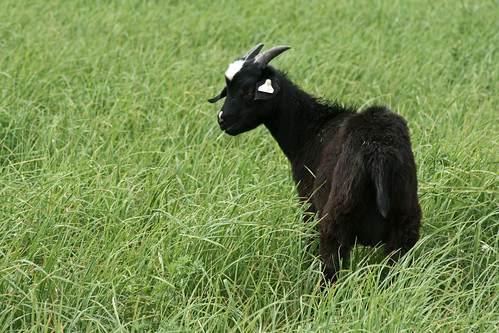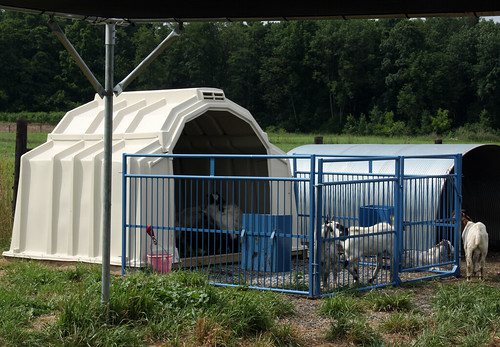 The goats were weighed by Jeff Semler. The data was recorded by David Gordon. Starting weights ranged from 25 to 70 lbs. (11.4 to 31.8 kg). The sixty buck kids averaged 48.1 lbs. (21.9 kg). During the 12-day adjustment period, the goats gained an average of 1.2 lbs. or 0.10 lbs. per day (45.5 g). Weight gain/loss ranged from -9 lbs. to + 11 lbs.
The goats were weighed by Jeff Semler. The data was recorded by David Gordon. Starting weights ranged from 25 to 70 lbs. (11.4 to 31.8 kg). The sixty buck kids averaged 48.1 lbs. (21.9 kg). During the 12-day adjustment period, the goats gained an average of 1.2 lbs. or 0.10 lbs. per day (45.5 g). Weight gain/loss ranged from -9 lbs. to + 11 lbs.Susan Schoenian assessed FAMACHA© scores, body condition scores, and coat condition scores. Pam Thomas recorded the data. As expected (due to the multiple deworming on June 6), FAMACHA© scores improved and no goat required deworming. FAMACHA© scores ranged from 1 to 3 and averaged 1.6. They averaged 1.8 on June 6.
 Body condition scores remained unchanged at 2.7. We began assessing coat condition scores (as an indicator of health and vigor) on a scale of 1 to 3, with 3 being the best (healthiest).
Body condition scores remained unchanged at 2.7. We began assessing coat condition scores (as an indicator of health and vigor) on a scale of 1 to 3, with 3 being the best (healthiest).For the past few days, the goats have been grazing a tree pasture with mixed forage species, including some warm season grasses. The recently planted two-acre field of dwarf pearl millet and brassicas is coming up nicely. The two acres of chicory is growing back after mowing. The goats are currently grazing cool season grass pastures (MaxQ™ tall fescue and orchardgrass): the vegetative regrowth after a hay crop was removed.
 A few goats are being treated for fevers, coughs, snotty noses, and ear tag infections. When a goat requires multiple treatments, it is moved to the new treatment enclosure: a 9 x 7 ft. Super Calf hutch with a 8 x 8 ft. outside pen area. They are fed hay while in the treatment pen. A similar isolation pen is located outside of the pasture and is reserved for goats with potentially contagious diseases (e.g. abscesses).
A few goats are being treated for fevers, coughs, snotty noses, and ear tag infections. When a goat requires multiple treatments, it is moved to the new treatment enclosure: a 9 x 7 ft. Super Calf hutch with a 8 x 8 ft. outside pen area. They are fed hay while in the treatment pen. A similar isolation pen is located outside of the pasture and is reserved for goats with potentially contagious diseases (e.g. abscesses).The next time the goats will be worked is Thursday, July 2.
Download June 18 report











